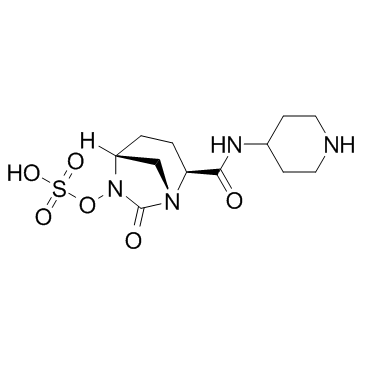1174018-99-5
| Name | MK-7655 |
|---|---|
| Synonyms |
relebactam
MK7655 (2S,5R)-sulfuric acid mono{[(4-aminopiperidin-4-yl)carbonyl]-7-oxo-1,6-diazabicyclo[3.2.1]oct-6-yl}ester (2S,5R)-7-oxo-N-piperidin-4-yl-6-(sulfooxy)-1,6-diazabicyclo[3.2.1]octane-2-carboxamide (2S,5R)-7-oxo-2-(piperidin-1-ium-4-ylcarbamoyl)-1,6-diazabicyclo[3.2.1]octan-6-yl sulfate |
| Description | Relebactam is a diazabicyclooctane inhibitor with activity against a wide spectrum of β-lactamases, including class A (extended-spectrum β-lactamases [ESBLs] and KPC) and class C (AmpC) enzymes.Target: beta-lactamaseImipenem with Relebactam is active against Escherichia coli, Klebsiella pneumoniae, and Enterobacter spp., including K. pneumoniae carbapenemase (KPC)-producing isolates. The combination of Imipenem with Relebactam demonstrated activity against KPC-producing Enterobacteriaceae and multidrug-resistant P. aeruginosa. The imipenem MIC50 and MIC90 values for the ESBL-producing isolates were 0.25 and 0.5 μg/ml, respectively; with the addition of Relebactam, the corresponding values were 0.25 and 0.25 μg/ml. Five isolates harbored blaKPC. For these 5 isolates, the imipenem MICs ranged from 0.5 to >32 μg/ml. With the addition of Relebactam, the MICs decreased to 0.12 to 0.5 μg/ml.[1] Relebactam inhibits most class A and class C β-lactamases, with selected inhibition of class D enzymes by avibactam. β-Lactamase inhibitors (BLIs) have played an important role in combatting β-lactam resistance in Gram-negative bacteria, but their effectiveness has diminished with the evolution of diverse and deleterious varieties of β-lactamases.[2] |
|---|---|
| Related Catalog | |
| References |
| Molecular Formula | C12H20N4O6S |
|---|---|
| Molecular Weight | 348.37500 |
| Exact Mass | 348.11000 |
| PSA | 136.66000 |
| LogP | 0.53390 |
| Storage condition | 2-8℃ |
